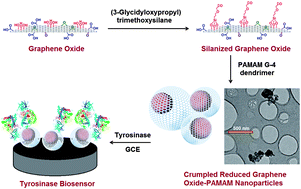Crumpled reduced graphene oxide–polyamidoamine dendrimer hybrid nanoparticles for the preparation of an electrochemical biosensor†
Abstract
Reduced

* Corresponding authors
a
Department of Analytical Chemistry, Faculty of Chemistry, Complutense University of Madrid, 28040-Madrid, Spain
E-mail:
pingarro@quim.ucm.es, rvillalonga@quim.ucm.es
Fax: +34 913944329
Tel: +34 913944315
b Department of Organic Chemistry I, Faculty of Chemistry, Complutense University of Madrid, 28040-Madrid, Spain
Reduced

 Please wait while we load your content...
Something went wrong. Try again?
Please wait while we load your content...
Something went wrong. Try again?
E. Araque, R. Villalonga, M. Gamella, P. Martínez-Ruiz, J. Reviejo and J. M. Pingarrón, J. Mater. Chem. B, 2013, 1, 2289 DOI: 10.1039/C3TB20078G
To request permission to reproduce material from this article, please go to the Copyright Clearance Center request page.
If you are an author contributing to an RSC publication, you do not need to request permission provided correct acknowledgement is given.
If you are the author of this article, you do not need to request permission to reproduce figures and diagrams provided correct acknowledgement is given. If you want to reproduce the whole article in a third-party publication (excluding your thesis/dissertation for which permission is not required) please go to the Copyright Clearance Center request page.
Read more about how to correctly acknowledge RSC content.
 Fetching data from CrossRef.
Fetching data from CrossRef.
This may take some time to load.
Loading related content
